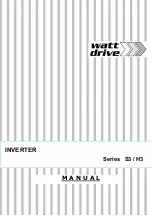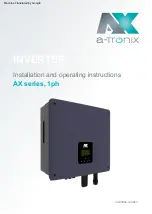
Operation
26
900-0161-01-01 Rev B
Generator Input
A generator should be sized to provide enough power for all inverters, both for loads and for
battery charging. The generator’s voltage and frequency must match the Radian inverter’s
acceptance settings. Some generators may not be able to maintain AC voltage or frequency for
long periods of time if they are loaded more than 80% of rated capacity.
The generator is required to have a stable output before its power is accepted by the inverter.
Some generators with less stable or uneven outputs may not be accepted. The use of the
Generator
input mode may assist with this problem.
If a smaller generator must be used, the
Support
input mode may be able to provide support to
the loads from the batteries during peak load times. The inverter can recharge the batteries
during non-peak times.
Transfer
The inverter uses a transfer relay to alternate between the states of inverting and of accepting
an AC source. Until the relay energizes, the output terminals are electrically isolated from the
input that is in use. When it closes, the input and output terminals become electrically common.
(The terminals for the unused input remain isolated during this time.) When the relay changes
states, the physical transfer delay is
approximately
25 milliseconds.
CAUTION: Equipment Damage
Current draw in excess of the transfer relay rating can damage the transfer relay. This
damage is not covered by warranty. Use protective devices of appropriate size.
The relay contacts are limited to 50 amps per phase or leg. The continuous loads on that output
should never exceed this number. When connected to an AC source, the Radian inverter
cannot limit the load current. An overload condition is possible.
The inverter does not filter or actively condition the AC source. The voltage and power quality
received by the output loads is the same as that of the source. If the voltage or quality do not
meet the inverter’s input requirements, it will disconnect and return to the inverting mode.
NOTES
:
To ensure a smoother transition, it may be advisable to raise the inverter’s lower acceptance limit.
The default setting is 108 Vac on both the L1 and L2 input lines. A higher setting will cause the
inverter to transfer sooner in the event of a quality problem.
If the AC source meets the inverter’s requirements but is irregular, any fluctuations will be transferred
to the loads. If the loads are sensitive, it may be necessary to improve the quality of the AC source.
The
Generator
input mode is intended to accept irregular or unfiltered AC sources and is more likely
to do so than other modes. This should be considered before using this mode with sensitive loads.
(See page 12.)
If the charging function is turned off, the inverter will transfer power from the source but will not
use it to charge. If the inverting function is turned off, the inverter will transfer (“pass through”)
the source power when connected, but will not invert when the source is removed.
In a stacked system, slaves are ordered to transfer at the same time as the master. If a slave
does not sense an AC source at the same time as the master, it will experience a
Phase Loss
warning (see page 52). This appears as an event on a MATE3-class system display.
NOTE
: A slave in
Phase Loss
will continue supporting the master inverter’s output.
Содержание OutBack Power GS8048A
Страница 1: ...Radian Series Inverter Charger GS4048A GS8048A Operator s Manual ...
Страница 6: ...Table of Contents 6 900 0161 01 01 Rev B THIS PAGE INTENTIONALLY LEFT BLANK ...
Страница 20: ...Operation 20 900 0161 01 01 Rev B NOTES ...
Страница 56: ...Troubleshooting 56 900 0161 01 01 Rev B NOTES ...
Страница 67: ...Specifications 900 0161 01 01 Rev B 67 NOTES ...
















































